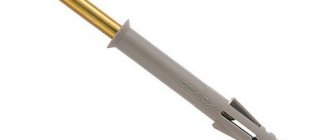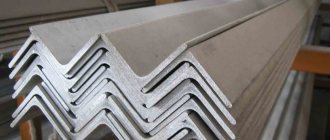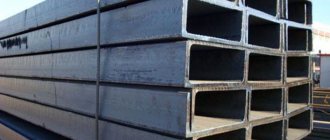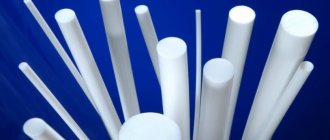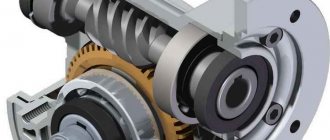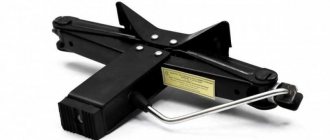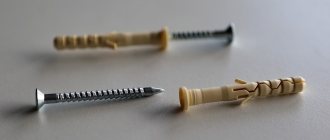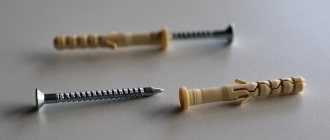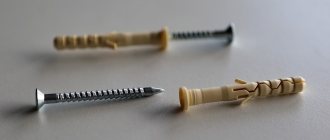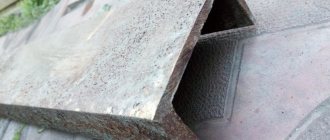Concrete is a very diverse material. A mortar can include a variety of components, have very different density and permeability characteristics, and be intended for a variety of needs. Accordingly, it is impossible to offer universal fasteners that would be suitable for all types of this material.
Dowel is the most suitable option for working with concrete.
Dowel concept
To be fair, the dowel is not the fastening itself, but that part of it that is inserted into the base and provides the very possibility of fastening. Its predecessor was an ordinary wooden plug - a chopik, which was driven into the walls so that it became possible to drive a nail into the base.
The dowel still plays the same role today. But, it is true, modern models offer the possibility of mounting on a wide variety of materials: heavy concrete and porous, hollow brick and dense natural stone, gypsum, drywall and loose slag concrete. The design of the product provides such wide possibilities.
A dowel is a sleeve or sleeve. The dowel itself does not form a fastening, but is firmly fixed in the wall material. An object or material is secured by screwing or driving a nail, screw or screw into the sleeve. At the same time, the sleeve changes shape - it expands, twists, folds, that is, it forms a very reliable adhesion to the base.
Classic dowels for concrete surfaces
Naturally, dowel fastening of various objects on concrete must be of high quality. The classic option is a plastic bushing with notches along the length and so-called “whiskers” used to prevent the fastener from turning through the hole. The main element of such fastening is a special rod, which contributes to the strength of the fastening in the wall, because when it is used, the bushing in the mounting hole expands. The classic mount is also quite easy to remove. The notches on the rod make it easier to unscrew with a screwdriver.
Return to contents
Specifications
One of the main parameters of any material on which physical activity is expected to be applied is its technical characteristics. For dowels, the main indicators are as follows:
the length of standard products ranges from 40 to 140 mm, in increments of 20 mm;
metal nail diameter - from 5 to 7 mm;
The diameter of the hole that should be made in the wall surface is from 6 to 10 mm. The designation of the fastener model is made up of two indicators: hole diameter and length, and looks like 6x40, 8x100, 10x100, etc.
The maximum thickness of materials that the dowel can attach is from 10 to 100 mm. This indicator is important to take into account when preparing materials for thermal insulation, since incorrectly selected fasteners may simply not reach the wall, or the location of its opening will not be deep enough.
Fasteners are produced from high-quality steel grades St 50, 60, 70, galvanized to prevent corrosion. The opening part is made from various polymer materials: polyethylene, polypropylene, polyamide. The first two materials have low resistance to negative temperatures, while polyamide is well suited for external work, for example, for thermal insulation and waterproofing of a house, installation of sheathing under siding or a block house, etc.
Manufacturers rating
The Russian market offers dowels from foreign and domestic manufacturers. In terms of quality, Russian production is catching up with foreign analogues. The difference between them is primarily in price.
A popular supplier of facade dowels to the market is the fiberglass plant in Biysk. The product has low thermal conductivity due to its fiberglass material. The range of products consists of fasteners of various lengths with an anchor area of 50 and 80 mm and a cross-section of 1 cm, 5 mm, 7 mm, designed for fixing any insulation into bases of different densities. The standard diameter of the cap is 6 cm.
About a quarter of the fastening products market is occupied by the Tech-Krep trade and production association. The company produces products with izo plastic nail, izm galvanized nail, izl impact resistant polyamide head, izr steel nail and protective cover. Different lengths of the rod are capable of fixing the insulating layer from 5 cm to 24 cm. The anchor part is from 4 to 6 cm.
To fasten thermal insulation up to 15 cm, use fasteners with a plastic nail. Metal nails are used for materials up to 24 cm thick. The protective thermal head allows you to avoid corrosion during subsequent plastering of the facade.
Under the Termozit brand, the market offers façade dowels with a multi-colored thermal head on a galvanized nail. The polyethylene head on the rod prevents the appearance of corrosion and cold bridges at the attachment point. There are product models with anchor bases from 40 to 70 mm. The length of the structure varies from 95 to 300 cm.
The Russian company specializes in the production of facade anchor fasteners of four brands. The EFA-F modification is distinguished by the presence of a galvanized screw of increased strength. The EFA-FН and EFA-FСН brands have screws with an anti-corrosion coating with a strength of 6.8 and 8.8, respectively. The EFA-FA4 brand represents products with stainless steel screws.
Foreign manufacturers on the domestic market are represented by the brands Sormat, Mungo and Fischer. supplies façade dowels with nail, screw and hex washer. Fasteners are made of nylon and meet European requirements for installation products.
Finnish produces products with an increased wedge area. This allows you to securely fasten the material to any surface. The spacer structure with a 115 mm screw with a hexagon at the base is intended for fastening consoles and brackets.
A well-known supplier from Switzerland is . It offers three varieties of its products to the market. For fastening to solid bases made of concrete and brick, a dowel with a rod made from an MBR screw is suitable. With an increased anchor area, MV fasteners for hollow supports are produced. The universal design of the MQL brand is capable of fixing thermal insulation on any base due to four wedges of different distribution.
Types of dowels
In stores you can find a large selection of different dowels. But each of them is created for one purpose or another.
Universal polypropyleneThe simplest, but suitable for most types of work, including stone, concrete and brick. When screwing in the self-tapping screw, the dowel material is wound onto the metal, thereby securing the structure |
Universal expansion dowelIt is also made of polypropylene, but has special spacers, due to which it is held inside the hole |
Dowel nailAllows you to quickly and efficiently fasten windows, sheathing, skirting boards, beams, cable ducts, metal profiles, as well as plywood into concrete, stone or brick surfaces. Made of nylon or polypropylene, nail made of steel |
Drywall dowelDesigned for mounting various elements into sheets of plasterboard or gypsum fiber, as well as porous concrete. This fastener is made of plastic or metal. The second option (also called a “molly” dowel) does not require pre-drilling holes, since the tip of the metal dowel looks like a feather drill |
Nylon dowelAs the name suggests, it is made of nylon. It can be used in almost any situation and on any surface. Due to the presence of fastening antennae, the nylon dowel is securely held in the wall. Self-tapping screws for such a dowel usually have a diameter of 0.02-0.16 cm |
Butterfly dowelDesigned to perform serious installation work. This fastener can withstand enormous loads even if there are hollow walls. Made from metal |
Adjustment dowelWith its help, the sheathing is attached for future cladding. The main feature of this type of fastener is the ability to regulate (adjust) the position of the elements relative to the base to which they are attached |
Dowel-umbrellaA special type of dowels designed for installing thermal insulation made of mineral wool and polystyrene. The appearance of the fastener fully explains its name: a wide round cap, the main purpose of which is to hold the insulation against the wall. “Umbrellas” are made of both plastic and metal. But “umbrellas” are also called another type of dowels designed for working with drywall, mostly with hanging structures. This metal “umbrella” Molly is a nail with metal shoulders that are securely attached to a hollow structure, evenly distributing the load. Using this type of dowels you can easily hang any chandelier in a suspended ceiling |
Dowel clampIt looks like a loop made of plastic (nylon), with “antennae” along the edges, due to which the fastener will be held. Clamps are designed for mounting electrical wiring to the wall. Working with this type of dowel is very simple: first, a hole of the required diameter and depth is drilled, and then the required wire is simply pressed with a clamp, the edges of which are inserted into the previously drilled hole. They can also be used to attach small-diameter corrugated pipes |
Frame dowelIt is made of metal, since its area of application is very specific. Designed for installation of window and door frames. A metal frame dowel is also suitable for fastening the sheathing through a layer of plaster and thermal insulation. |
Types of anchors used for working with brick structures
When working with bricks, mechanical and chemical type anchors are used. The most popular are hardware that uses mechanical methods of fixation in the wall. For brick walls, the most popular types of products are:
- Drive-in anchors, ideal for use with solid sand-lime bricks or cinder blocks;
- Wedge anchors used for installation of façade curtain systems and external glazing on brick walls of various types;
- Double-spacer, designed for mounting critical massive structures and objects to walls made of solid brick;
- MSA anchor systems for fixing lightweight parts to brick structures of any type;
- Anchor bolts with hexagonal head. Suitable for any walls made of piece elements.
Manufacturers also produce other types of hardware products, which are not very widely distributed and are used mainly for special types of work related to the installation of equipment or finishing elements.
Main advantages
The dowel element has a range of advantages:
- does not scroll in weakened channels;
- holds well in porous building materials;
Metal dowel for sheet materials W-GS, type Z/L - withstands significant forces without changing the initial position;
- does not allow the fastening element to fall out;
- does not become loose under alternating loads;
- easily enters building materials upon impact.
Along with increased performance characteristics, dowel fasteners are reliable and durable.
Materials
Which material is preferable? It would seem that what could be more reliable than metal? The advantages of this material are obvious: strength, durability, ability to withstand heavy loads. However, metal spacer fasteners also have disadvantages. First of all, their high price and, oddly enough, lack of universal use. As a rule, such dowels are used for mounting any structures to brick walls. It is perfect for hanging various large equipment: gas boiler, water heater, heating system elements, sports equipment, grilles, awnings, etc. A special type of metal consumables are frame fasteners designed for fastening window and door frames to brick walls.
In general terms, the design of a metal dowel is quite simple; in fact, it is a tube with an internal thread, at the working end of which slots are made, and its thickness becomes larger.
During the installation process, the dowel is inserted into a prepared hole of the appropriate diameter, and then a pin with an external thread is screwed into it. The pin expands the dowel petals, and they are securely fixed in the hole.
It is much cheaper to make dowels from plastic. This has resulted in a huge variety of plastic expansion dowels. The simplest of them have the same principle as described above for their metal counterparts.
A screw or self-tapping screw is screwed into the plastic sleeve; a special nail with a threaded notch can also be driven in. The introduction of a metal rod leads to expansion of the petals of the structure, which reliably fix the dowel in the material. Plastic dowels for hollow bricks have a special design.
During installation, their petals are twisted into tight “knots”, this helps fix them in voids. Reinforced plastic dowels can easily compete in terms of fastening reliability with some models of metal dowels. The use of plastic consumables is very widespread. From mounting pictures and mirrors to securing heavy equipment.
What material is the dowel plug made of?
Most fasteners are made from plastic. This is due to the low cost, availability, increased performance characteristics of the material, as well as the lack of the need to apply significant effort when screwing fasteners.
Various types of polymer materials are used for the manufacture of plastic retainers.:
- polyethylene. Easily deformable while maintaining integrity. It is lightweight and resistant to corrosion. Can be used when temperatures drop to 40 degrees below zero. Disadvantage: gradual loss of performance properties and cracking;
- polypropylene. It is used mainly indoors, as it is susceptible to negative temperatures. Advantages: increased hardness, wear resistance, and the ability to operate at high temperatures. The weak side is the appearance of cracks during long-term operation under temperature changes;
- polyamide. The material is also known as nylon. It is little subject to wear and is not afraid of mechanical stress. The nylon fastener is the most durable and reliable among other plastic fasteners.
Dowel for thermal insulation with a metal nail and thermal plug Strezzar Standard ST-M10x140 - 1
Along with plastic clamps, metal products are used :
- of stainless steel;
- galvanizing;
- alloys based on brass or bronze.
Despite the increased strength characteristics and rigidity of metal fasteners, they are inferior to plastic in their ability to deform while maintaining integrity. At the same time, the metal is able to withstand increased loads. Protective coatings significantly increase the service life of metal dowel elements.
Types of products
Dowels even have the same purpose, but differ from different manufacturers in their design - the presence or absence of a collar, the design of fixing and guiding elements, the number of thrust directions, and so on. This applies primarily to plastic fasteners, while the design of a metal dowel for concrete is practically unchanged.
Obviously, the design features of products for dense and cellular concrete will be different. However, what is common is the material of manufacture. Plastics are the best solution due to their combination of hardness and toughness, which, for example, metal cannot boast of.
- Polyethylene – low and high pressure. It is a dielectric, stable at temperatures down to -40 C, safe and does not allow water to pass through, is not susceptible to corrosion, rot or mold, and is resistant to most chemically aggressive substances. Its main disadvantages include flammability, so if the dowel is used without restrictions in construction work, then it should not be used for fastening communications such as a gas pipeline.
- Polypropylene is also a dielectric and is more hard and cold-resistant than polyethylene. The disadvantage is the same - the material is flammable and continues to burn after the source of fire is removed.
- Polyamide is hard, even rigid, but at the same time it has high viscosity and can easily withstand deformation. In addition, polyamide is vibration-resistant, wear-resistant and not subject to cracking. It ignites and burns after the source of fire is removed.
Special additives are often introduced into the composition of such materials, reducing the tendency to ignite and even giving the product the ability to self-extinguish. In terms of characteristics, polyamide fasteners are considered the best. However, the latter absorbs more moisture than other types of plastic, so installing nylon dowels in rainy or frosty weather is prohibited.
Metal fasteners provide higher load-bearing capacity, but also have their drawbacks - a tendency to corrosion.
- To protect the product, steel dowels and screws are coated with a layer of zinc.
- It is also possible to manufacture fasteners from stainless steel: this option is used in the most critical areas, since its cost is very high.
- There are products made of brass, but extremely rarely: the material is expensive and justifies itself only when used in difficult conditions.
Next, we will consider the dimensions and GOST requirements for dowels for concrete and aerated concrete.
Facade dowels and anchors for aerated concrete
Dowel installation procedure
The procedure for installing a dowel into a brick wall consists of the following steps.
- The first thing to do is to carefully drill a mounting hole for mounting the fastener. This can be done using an electric drill or hammer drill with only drilling mode (no impact) turned on. It is important that the diameter of the drill used to perform this procedure exactly matches the diameter of the dowel itself.
- After drilling, the hole must be thoroughly cleaned of construction dust and pieces of material that have crumbled into its internal cavity. You can check how thoroughly you have cleaned the hole using the dowel itself: it should fit in without difficulty or obstacles.
- When the hole is thoroughly cleaned, you can begin work with dry tile adhesive, which must be diluted with water in the proportion specified by the manufacturer. After the adhesive mass is ready for use, it is necessary to fill the hole drilled for the dowel. You can use a rubber spatula for this, and you can push the adhesive mass into the depth of the hole using the dowel itself or an ordinary pencil. When the hole is completely filled with adhesive, you can insert a dowel into it, which should go into it all the way. After this, you need to let the adhesive composition completely harden, which is quite enough for 24 hours.
- After the tile adhesive has completely hardened, you can screw a threaded element (pin or screw) into the dowel. In this case, be sure to pay attention to the fact that screwing occurs with some force. This means that your dowel is securely fixed into the brickwork. Fasteners obtained using this simple technology are highly reliable and can withstand even significant weight loads.
You can also use this method if you need to install fasteners in a porous material (the use of concrete dowels for such structures is also prohibited). Such materials, in particular, can be gas or foam concrete, porous brick, etc. Taking into account their high popularity in the modern construction market, the choice of fasteners that could ensure reliable fastening of objects fixed on such structures is a rather serious problem.
Installation
Features of installing a dowel in concrete are related to its design and the nature of the material. The methods differ, although in all cases they involve pre-drilling holes.
Installation technologies
On dense concrete
This classic product is also secured in a very classic way.
- A hole is drilled in the wall or ceiling. For drilling in heavy concrete, both an electric drill and a hammer drill are suitable. It is important to choose a drill whose diameter exactly matches the diameter of the dowel.
- The depth of the hole should exceed the length of the fastener by 3–5 mm. It is best to clarify this information in the manufacturer’s catalog, where all the necessary parameters are indicated: minimum drilling depth, recommended load, thickness of the material being fixed, and so on.
- A sleeve is inserted into the hole. If necessary, hammer the dowel with a rubber hammer or a regular one if we are talking about a metal product.
- A screw is inserted into the sleeve through the material to be fixed and tightened until the collar is pressed against the surface of the material. In this case, the spacer part of the sleeve expands and is fixed in the wall.
Universal fasteners require slightly different handling: the screw in the dowel is turned twice. Installation of the frame dowel is carried out using the same method, but more attention has to be paid to the hole: you need to accurately calculate its depth.
Features of using dowels
When choosing a dowel, it is not enough to focus on its shape; it is also important to know what size (length, diameter) to choose. For each working surface it is necessary to select its own fasteners. The “six” dowel (6*40) is suitable for installing profile structures in cinder block houses. By choosing a different size, it will not be possible to make repairs, since all the fasteners will simply fall out of the drilled holes.
For panel houses (as well as those where there are no voids in the walls), the best option for dowels is 6*60 or 6*80. With them, everything will be securely fastened, nothing will fall through or fall out even on the ceiling.
When choosing the length of the dowel, it is worth remembering the load that the fastener will be subjected to in the future during operation. The shorter the dowel and self-tapping screw, the less load it will withstand. The diameter is also important. For ordinary housework (hanging a cabinet, mirror or wall unit), dowels with a diameter of 8-10 mm are sufficient. The only difference is the depth of the hole being drilled, since the load on the dowel is different.
For a cabinet, 3-5 cm is enough, and for a wall unit or a heavier cabinet or shelf - 8-10 cm. Another important question that arises before the master is what kind of drill is needed for the dowel. To answer this, you first need to know what surface will be drilled and what load on the structure is planned in the future after the work is completed.
Typical sizes
Let us present the main characteristics of universal products in the form of a table:
| Type | Dimensions | Installation | Permissible load (brick, concrete) | ||||||
| d | L | t | d0 | h1 | Nbet. | Vbet. | Nbrick. | Vbrick. | |
| Expandet Nail Anchor | Ext. anchor diameter, mm | Anchor length, mm | Max. thickness of fixing item, mm | Diameter dia. holes, mm | Min. height depth holes, mm | Tensile load, kg | Cross-river load, kg | Tensile load, kg | Cross-river load, kg |
| 5×30 | 5 | 30 | 5 | 5 | 40 | 30,59 | 35,69 | 20,39 | 35,69 |
| 5×40 | 5 | 40 | 15 | 5 | 50 | 30,59 | 35,69 | 20,39 | 35,69 |
| 5×50 | 5 | 50 | 25 | 5 | 60 | 30,59 | 35,69 | 20,39 | 35,69 |
| 6×35 | 6 | 35 | 5 | 6 | 45 | 45,88 | 56,08 | 30,59 | 56,08 |
| 6×40 | 6 | 40 | 10 | 6 | 50 | 45,88 | 56,08 | 30,59 | 56,08 |
| 6×50 | 6 | 50 | 20 | 6 | 60 | 45,88 | 56,08 | 30,59 | 56,08 |
| 6×60 | 6 | 60 | 30 | 6 | 70 | 45,88 | 56,08 | 30,59 | 56,08 |
| 6×70 | 6 | 70 | 40 | 6 | 80 | 45,88 | 35,69 | 30,59 | 35,69 |
| 8×50 | 8 | 50 | 10 | 8 | 60 | 56,08 | 91,77 | 45,88 | 91,77 |
| 8×60 | 8 | 60 | 20 | 8 | 70 | 56,08 | 91,77 | 45,88 | 91,77 |
| 8×80 | 8 | 80 | 40 | 8 | 90 | 56,08 | 91,77 | 45,88 | 91,77 |
| 8×100 | 8 | 100 | 60 | 8 | 110 | 56,08 | 50,98 | 45,88 | 50,98 |
| 8×120 | 8 | 120 | 80 | 8 | 130 | 56,08 | 50,98 | 45,88 | 50,98 |
| 8×140 | 8 | 140 | 100 | 8 | 150 | 56,08 | 50,98 | 45,88 | 50,98 |
| 10×80 | 10 | 80 | 30 | 10 | 90 | 76,47 | 50,98 | 56,08 | 50,98 |
| 10×100 | 10 | 100 | 50 | 10 | 110 | 76,47 | 50,98 | 56,08 | 50,98 |
| 10×120 | 10 | 120 | 70 | 10 | 130 | 76,47 | 50,98 | 56,08 | 50,98 |
| 10×140 | 10 | 140 | 90 | 10 | 150 | 76,47 | 50,98 | 56,08 | 50,98 |
| 10×160 | 10 | 160 | 110 | 10 | 170 | 76,47 | 50,98 | 56,08 | 50,98 |
Table 1.
Here the lateral load is the weight that the dowel can support. This is a force directed vertically. That is, from the center of the edge of the fastener to the ground.
How to choose a drill for a dowel
The most important rule is that the drill number must match the number (size) of the dowel. That is, ideally, the dowel should be driven into the wall with difficulty, otherwise, a situation is possible when the dowel simply falls out or fails. As for the quality of drills, experienced craftsmen advise using pobedit ones, since buying more expensive ones does not make much sense. Making a hole for a dowel is easy (for example, take dowel 10):
- First, take a smaller drill bit, such as an 8-point drill. Make the hole slightly smaller in depth than necessary using the impact mode.
- Then you will need a drill that is the same size as the dowel, that is, a 10-piece. Turning off the impact mode, finish the desired hole.
By following these rules, you will do everything without problems.
Hollow brick
What kind of material is this? In modern construction, two types of bricks are used - hollow and solid. The main function of the first materials is the construction of buildings, which should be as strong and durable as possible.
This brick is good in all respects. The material is light, strong, and easy to install. However, it has a significant drawback. It does not retain heat well in rooms. Although hollow brick is practically no different in strength from solid brick, it is more often used in finishing work. The internal void in such a building material can range from 30% to 50%, depending on the type and manufacturer. Low-melting grades of clay are used as raw materials for such blocks. It is from this that red brick is made. There is another option. This is a silicate hollow white type. Let's look at the features and properties of mounting blocks.
Where are dowel nails used?
These fasteners are used to create a reliable connection in places that are difficult to reach with a screwdriver, or in cases where such a tool is not at hand. The second important reason for this choice is the speed of installation, due to which such a metal nail is significantly superior to analogues. To install these nails, you do not need to make precise markings to perfectly match the hole in the material. The nest for them is drilled directly through the attached material, after which the dowel is installed in the hole and driven in with a hammer. Such a nail for the baseboard can speed up the work several times without changing the quality of the fastening.
It is very common to use fasteners for thermal insulation of external and internal walls of a house. Features of fastening with hard materials (concrete, brickwork) allow the use of dowels and mounting nails for covering walls with facing materials or plasterboard.
Dowels designed to work with a mounting gun are very convenient for fastening metal structures to a brick, concrete or wooden base. A clear example of such work is the installation of metal canopies over balconies and windows.
Fasteners for concrete walls
When determining which dowel is best for concrete, it is necessary to consider fasteners only for this material, since they differ in certain features. Thus, a brick dowel is not suitable for fastening into a concrete monolith and vice versa. The surface structure is also important - the porosity of the monolith and the presence of cavities in it must be taken into account.
The dowel-nail for concrete and brick is distinguished by a sleeve - classic smooth fasteners can simply be driven (hammered) into the monolith, efficiently and quickly, without the use of special techniques and the expenditure of time, effort, and finances. In brick or aerated concrete, for example, a sleeve without spacer elements will simply destroy the mounting hole due to the presence of cavities and looseness of the material.
The dowel marking always includes a description of the type of material for which the fastener is suitable: for concrete you need to select the appropriate elements and nothing else.
Tips for choosing
In the catalog from a well-known manufacturer you can find a wide variety of products. Moreover, comparative tables contain data on what depth a particular dowel should be immersed, what load it is designed for, and even how it will behave in a particular environment.
As a result, the most important thing is to find out what the builder is actually dealing with in each specific case.
Base material
In dense concrete, old concrete, aerated concrete, the same fastener behaves completely differently and can withstand different loads. So finding out what exactly the walls and ceiling in the apartment are made of is very important. This can be done using a fairly simple test: dust from a drill hole.
- Concrete is a material that offers strong resistance when drilling. Drill flour is finely ground, hard, free-flowing, the color varies from white to light gray.
- Old and stretched concrete - the color of flour is closer to gray. When drilling, “dips” are felt: the drill unexpectedly easily passes through the damaged areas.
- Foam or aerated concrete - the resistance of the material is low, the hole is larger than the diameter of the drill. The dust is light, mostly white, but coarse-grained and slightly sticky to the touch.
- Clay brick , both solid and hollow, produces reddish or yellowish dust, hard and free-flowing.
- In sand-lime brick , the flour is light, and the drilling resistance is greater.
- When drilling limestone, the dust will be white, sandy, and the resistance is average.
- Drilling into drywall produces white dust. It noticeably sticks to the channels on the drill. Gypsum fiber produces gray dust.
Even without knowing the exact brand of concrete or class of brick, this information is already enough to determine the category of dowels used.
Load nature
The most important thing here is to correctly determine the load and correctly calculate the power of the dowel. The latter is determined by the ratio of the diameter and length of the fastener.
In everyday life we most often deal with these types of loads.
- Horizontal shear - this load occurs when installing cabinets, shelves, pictures and larger structures on the wall. Fasteners are selected according to the weight of the product - from 6 to 10 mm. The length ensures fixation in the wall material. The dowel is immersed 30–50 mm into a solid base; in a loose or slotted recess it should be more.
- Vertical – the load that occurs when installing a chandelier, communications, or air conditioner on the ceiling. With the same dowel parameters, the penetration should be greater than into the wall. For example, with a diameter of 6 mm, the fastener must enter at least 40 mm into the wall, and into the ceiling - at least 60 mm.
For installation in the ceiling, you need to select a dowel with additional elements: transverse notches, spacer wings, and so on. The hole in the ceiling must exactly match the diameter of the dowel; the fasteners fit very tightly.
- Dynamic load – is formed during the use of a ladder, wall bars, horizontal bar or other sports equipment. In this case, bolted fastenings are preferable, since they are more resistant to vibration.
For greater reliability of fastening, the dowel is lubricated with PVA glue. When mounting on a ceiling, this technique is often recommended.
Features of the base and product
A special dowel has also been developed for special products. These models are not interchangeable except in special cases.
- For example, it is possible to replace the frame fastening with a facade one, since the latter also has a long non-expanding part and has a high load-bearing capacity.
- It is impossible to replace the dowel for fastening with sheet material - butterfly or molly. The products differ in the material of manufacture - plastic and metal, respectively, but have the same design: when the screw is tightened, the sleeve folds, pressing against the sheet.
- The universal dowel has a similar design, which also deforms in voids, forming a knot. However, for drywall, during its installation, this type of dowel is rarely used, since it is expensive. But when attaching to tiles or sheet steel, it is irreplaceable.
Plastic and metal dowels of the same design and purpose differ only in load-bearing capacity. They can be replaced within the same range. But if the structure being fixed is fire hazardous, only metal fasteners are allowed to be used.
- There is nothing to replace the dowel for thermal insulation - this is the only possible fastener for soft insulation.
- Obviously, you cannot use a general-purpose expansion dowel in aerated concrete: the material does not create sufficient friction force. However, fasteners for porous material are not installed in dense concrete: the shape possibilities in such a material turn out to be excessive.
Dowel is an extremely versatile fastener. Among its many types, you can find models for both solid and hollow material, for fixing heavy structures and loose insulation, for installing windows and communications.
Removing fasteners
When renovating an apartment, high-quality wall finishing is necessary. To prepare a room for wallpapering or applying any other decorative coating, it is necessary to level the walls, first freeing them from old fasteners.
Often you need to remove unnecessary dowels through which screws are attached. To do this, there are several simple ways to remove a dowel from a concrete wall.
For dismantling you will need:
- Self-tapping screw;
- Sharp knife;
- Corkscrew;
- Awl;
- Hammer;
- Punch;
- Soldering iron;
- Nail puller;
- "Bulgarian".
Dismantling method:
- To remove a regular plastic dowel, you can use a self-tapping screw of a suitable size. In this case, the self-tapping screw is screwed two-thirds into the dowel for a reliable connection with the part being dismantled. The head of the screw is clamped with pliers and pulled out together with the dowel. Sometimes you can use a regular table corkscrew;
- The head of the self-tapping screw screwed into the dowel is pryed off with a nail puller. Using this lever, the dowel is removed with less effort. But the main condition is a tight fit of the working part of the screw in the hole;
- The homemade wooden dowel is removed from the socket in parts. To do this, the element is crushed into several pieces along the wood fibers with a chisel with a thin blade and a hammer. After destruction, the dowel is carefully pryed up with a nail, the tip of a sharp knife or an awl, and pulled out;
- If the dowel sits firmly enough in the wall, it is not always worth pulling it out. In this case, with a sharp knife you need to cut off the part of the dowel that protrudes above the surface of the wall, and cover the resulting depression with construction plaster and carefully level it;
- When removing a dowel in which a piece of screw is stuck, use a heated soldering iron. The tool melts the plastic base of the dowel, then the piece of fastener is pryed off with wire cutters or pliers and pulled out of the socket;
- A metal dowel-nail driven into concrete with a construction gun should first be treated with frequent, fairly strong hammer blows on the protruding part of the part from different sides. Most often, the dowel becomes loose, and then it is relatively easily pulled out with a nail puller;
- If you cannot immediately loosen the metal dowel, you need to make a recess in the wall next to it using a drill with a carbide tip or a metal punch. This circular funnel reduces the adhesion area of the product to the wall material, which will make dismantling much easier. If this does not help, the protruding part of the dowel needs to be cut off with a grinder and the recess should be leveled.
To determine which dowel is best for concrete, you need to get acquainted with their types, advantages and disadvantages. In addition, it is worth understanding the technology for installing the product, and carefully following the basic construction rules when performing work.
This is interesting: Stainless steel profile pipe: types, characteristics, GOST
General view of dowels
A dowel is an auxiliary fastener that provides fixation of the main fastening element (screw) in the load-bearing base. The use of dowels facilitates installation, increases the strength and reliability of the connection, and prevents destruction of the base material under the influence of loads on the connection.
There are three types of dowels, differing in the type of fixation at the base:
|
|
|
Dowels of the first type are fixed in the base material due to the action of friction forces. This dowel has a spacer part, which, when the screw is screwed in, expands (wedges), rests against the channel walls, and is anchored. Previously, ordinary wooden dowels acted as spacer dowels; today they are made of plastic (usually nylon, polypropylene and polyethylene of various brands). Expansion dowels best withstand shear loads, therefore they are most often used for installation on vertical surfaces (walls). They are not used for mounting suspended structures on horizontal surfaces (ceilings, consoles), as they do not resist pulling out well.
The second type of dowel is fixed by creating persistent resistance outside or inside the base material. Such fasteners are structurally designed to change the shape during installation - expansion, tying into a knot, opening of stops, etc. Due to this, the anchoring (“anchoring”) of the dowel occurs, and it cannot be squeezed out. Anchor dowels work well both for shearing and extrusion, so they are suitable for installation on vertical and horizontal surfaces, including for hanging various products from the ceiling.
Anchor dowels are divided into two groups:
- With external support - used for installation on thin-walled materials (gypsum plasterboard, fiberboard, MDF, etc.);
- With internal stop – used for installation in both hollow and solid materials.
Dowels of the third type have a design that allows them to be used both as spacers and as anchors - it all depends on the base material. When installed in solid materials, the dowel acts as a spacer, being fixed due to friction forces. When installed in hollow materials, the spacer part of the dowel is deformed (usually tied into a knot), due to which it is anchored.
There is also another type of fastening joints - adhesive or chemical anchors. These products are fixed in the material using resin or special solutions.
It is necessary to make a note about what a dowel and an anchor are:
- A dowel is an auxiliary product that can be used with a screw of suitable characteristics (diameter and length). The dowel and screw are in most cases sold separately. Typically, dowels are made of polymer materials (nylon, polyethylene), but there are also metal dowels for screwing in screws with metric threads;
- The anchor is a finished product for which there is no need to purchase additional components. Typically, anchors are made of metal, which ensures high reliability and durability of installation based on them.
In the future, we will only talk about plastic dowels, their features, types and applications.
Facade dowel for fastening brackets
It differs from the usual one in configuration.
For the installation of ventilated façade elements, different types of dowels are used. At the same time, they differ not only in characteristics, functional features, materials of manufacture, properties and purpose, but also in manufacturers.
Some of them sell poor quality products on the market, some have one batch bad and another good.
What to do in such a situation? Specifically for the purpose of determining quality anchors, builders carry out tensile testing of the anchor. Thus, the selection of anchors is carried out.
The tests are carried out as follows. Fifteen control points are being installed. Holes are drilled in the wall, which are cleared of dust and wall particles.
Cleaning is done using a brush or construction pump.
Next, the anchor itself is installed, but without the bracket for which it is planned to be used. Using a hammer, it is driven into the resulting hole.
Next, it is tensioned to the required level. After this, a dosimetric key is attached to its end and its ability to withstand a certain pull-off force is measured.
Types and properties of anchor dowels
Thickness ranges from 10 to 16 mm. In this case, anchors ranging in size from 12 to 14 mm are most often used for this work.
The dowel should not be fragile and not very soft. It should not bend easily, nor break. Taking into account the operating conditions, the dowels must be made of stainless material or have an appropriate coating.
The minimum diameter of the anchor dowel should be 8 mm. The best option is considered to be 10 or 12 mm. The calculation is simple - the greater the load, the thicker the screw itself.
The anchor facade dowel has a number of advantages:
- thanks to the presence of a guide cone, the dowel can move around its axis;
- the petals during its installation do not allow it to rotate;
- a system of fixation ribs located in a checkerboard pattern ensures reliable immobilization of the dowel;
- Thanks to the Z-shaped cut, the screw fits precisely into the dowel, which ensures uniform pressure distribution over the entire surface of the nail.
When choosing an anchor dowel, you must consider:
- wall material;
- type of insulation and its thickness;
- climate zone;
- height of the building.
Chemical anchor
It is an anchor bolt of suitable dimensions, has anti-corrosion properties and is resistant to the chemical components contained in the adhesive solution, forming strong adhesion with them.
Its installation is carried out as follows: a hole is made in the wall, which is filled with a special two-component glue, after which a steel pin (the anchor itself) is inserted into it.
After the mixture has hardened and hardened, you can continue other work on creating a ventilated façade.
A chemical anchor provides stronger adhesion of the fastener to the wall and locally strengthens the wall itself. It has increased resistance to tearing out.
Expansion anchor for brackets
It is a bolt complete with a special sleeve made of stainless steel.
To install an expansion anchor, you need to drill a hole in the wall that matches the thickness of its sleeve. After this, fasteners are placed in it.
Strengthening in the wall is done by screwing. In this case, the static pressure created by the bolt leads to deformation in different directions of the spacer part of the sleeve of this fastening element. As the anchor expands, it becomes firmly stuck in the wall.
It is as easy to install as it is to remove. As the bolt is unscrewed, the pressure on the spacer part is relieved, which returns to its original position.
Often, an expansion anchor is used to install brackets for a ventilated façade into a wall made of foam concrete.
How to twist correctly
Screws for light and heavy concrete are no different. Self-tapping screws are used without dowels. The dowel is fastened after preliminary drilling of the hole. Retention at the base occurs according to the principle of an anchor screw. Afterwards, it is screwed through the part into the prepared hole. With notches for countersinking, the self-tapping screw firmly adheres to the part, due to the friction force, it additionally holds it and dampens vibrations.
It is important to use the self-tapping screw correctly, as you can easily break it off. It is necessary to tighten a screw with a non-countersunk head with a certain force, since due to high loads when tightening it can be broken by simply over-tightening
The risk of head breakage is also associated with the high heating temperature of the self-tapping screw body when screwing into concrete.
The order of twisting the dowel:
- Fastening of window and frame structures is carried out by at least two people.
- Align the structure to be strengthened and secure it.
- Transfer the installation dimensions to the hole drilling plane.
- Remove the structure and drill holes.
- Reinstall the structure and screw the screw through the structure into the prepared hole.
Table 1. Standard sizes of pre-drilled concrete screws.
Prices
The price of concrete screws is almost the same everywhere. The product is valuable: a pack of screws for 100 pieces costs from 250 to 550 rubles, the price is affected by the length of the screw. Many suppliers offer to buy self-tapping screws for concrete: the popularity of dowels among “window” and “door” workers has not gone away for the last 10 years. Installation organizations (electricians, plumbers) and construction companies also do not disdain this product. Turbo screws for monolithic construction sites are purchased en masse. The main selling sizes are 7.5*112, 7.5*132, 7.5*152.7.5*202.
Due to its popularity, it is produced both in the Russian Federation (according to GOST 9012-59) and imported in large quantities from Europe and China.
Which one is better to use?
It can be difficult to determine which type of dowel fastener is best suited for certain jobs, primarily due to the enormous variety. When purchasing dowels, of course, it is always advisable to consult the store so that you do not have to go to the store again. Let's try to give general recommendations. For solid brick, almost the same dowels are suitable as those recommended for concrete. If the walls are made of such material, you can say that you are in luck. Most universal dowels will work just fine. You can securely secure even heavy and bulky objects, not to mention shelves and cabinets.
It's a completely different matter if the brick is hollow. For hollow bricks, most universal dowels are completely unsuitable. Driving a dowel-nail into such a wall is dangerous, as it can cause the formation of cracks not only on the surface, but also in the partitions inside the brick; in this case, it will be simply impossible to fix anything in the same place, and the hole in the wall will have to be repaired.
For slotted and hollow bricks, special plastic dowels that roll into a knot are required, or metal anchors with petals that rest against the partition from the inside
You should work with such consumables very carefully, since, unlike solid bricks, those with voids are usually more fragile. Facing bricks that combine strength with some decorativeness require special care.
The appearance of chips and cracks in this case is simply unacceptable.
It is also important to remember that such bricks usually have voids to reduce their weight, which greatly limits the use of some anchors and dowel nails
For facing porous bricks, it is preferable to use elongated plastic dowels, which during installation form complex units that can securely fix them in the voids of such structures. The fasteners for red and sand-lime bricks are somewhat different. Red is usually softer, and there is a danger of turning the dowel in the hole if the diameter of the drill is incorrectly selected or during the drilling process the master failed to maintain the perpendicularity and the hole turned out to be slightly larger.
Selecting suitable self-tapping screws for drilling
Self-tapping screws are fasteners in the form of a rod that have a screw thread, a pointed end and a head. The thread holds the screw shaft in the wall, thereby ensuring fixation and immobility. According to the classification, self-tapping screws for drilling are divided into the following types.
- Universal, suitable for any fastenings - the most common.
- Self-tapping screws that strengthen metal sheets without dowels. Before screwing in the self-tapping screw, drilling is mandatory.
- Self-tapping screws without dowels for fastening soft metal and wood, plastic.
- Self-tapping screws in the form of a herringbone, capable of strengthening a concrete or brick wall, going along with dowels, by driving inward.
- Dowels - self-tapping screws without dowels, are needed to strengthen a brick wall or a concrete wall.
To choose the right self-tapping screws for drilling, it is important to consider what metal or alloy they are made of. The scope of application of these products depends on the material of manufacture.
- Stainless steel. A huge advantage is protection from moisture. The presence of metals such as chromium and nickel prevents such screws from rusting.
- Carbon steel. Compared to the previous type, this metal is not protected from moisture, but is more durable.
- Brass self-tapping screws for drilling are a relatively expensive but high-quality material. They can be used in both salty and acidic environments. Brass is resistant to corrosion, but this alloy is soft and deforms under heavy load.
If you choose self-tapping screws for drilling in concrete with a dowel, you need to take into account that the capsule is first hammered into it, and the screw itself is screwed into it. The mechanism is made in such a way that the sharp ends of the capsule dig into the wall as the screw is screwed into the hole, expanding the fastening area for a more durable attachment.
This fastening system, where a plastic sleeve expands the fastening area, is used in the following cases:
- increased load on screws;
- more rigid fixation for cellular concrete;
- the need to eliminate vibrations to prevent screws from unwinding.
In the absence of a dowel, you will also need to drill a small hole for self-tapping screws; it is also better to calculate in advance the length of the screw to be passed through. Otherwise, the self-tapping screw will either not reach the required depth or will sink into the wall. Re-installation may only damage the fragile hole in the concrete.
There are also so-called turbo screws. The advantage of such a screw is the variable thread, which has notches. It has good adhesion to the concrete wall. Such self-tapping screws can be screwed in with a regular drill; they do not require excessive effort. The turboscrew is suitable for cellular and hollow concrete blocks.
The color of the screws is also important. In relation to color, drilling screws are as follows.
- Silver - these screws are suitable for any climatic conditions. Prevents the onset of corrosion. Suitable for work both indoors and outdoors.
- Yellow – covered with a protective zinc coating with an admixture of copper. Are used only for interior work.
- Black – contain an oxide film. Such screws are not suitable in rooms with a high percentage of humidity, for example, in bathhouses and greenhouses it is undesirable to use such fasteners.
When tightening self-tapping screws with a conventional drill, it is important to choose a drill, taking into account the following recommendations:
- the drill should be a couple of millimeters smaller than the self-tapping screw;
- when using a breaker tool, it is better to purchase a drill that has recesses on the clamping part of the drill;
- When drilling, you can use a universal brick drill bit for a drill.
You will learn more about concrete drills from the video.
